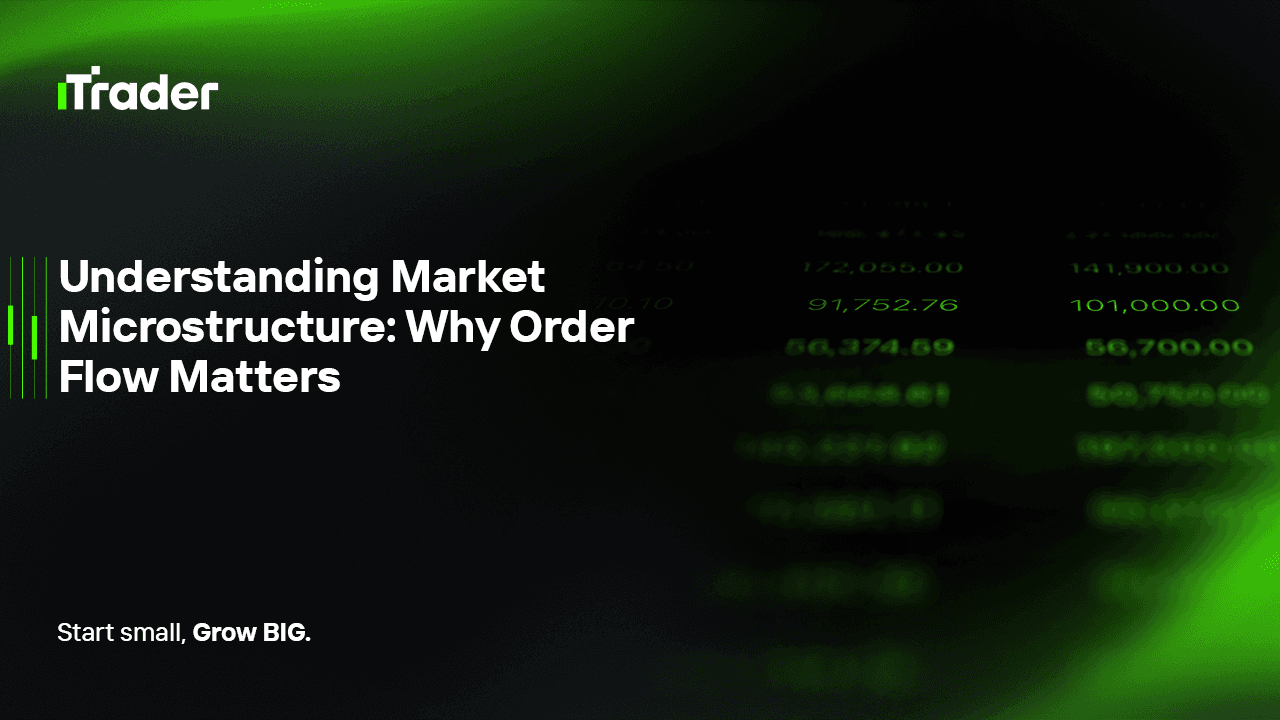2025-07-02
To the average trader, markets appear as a stream of prices moving up and down. But what causes those movements? What drives that next tick in the price of EUR/USD or S&P 500 futures?
The answer lies not in broad economic theory, but in the microstructure of the market—the mechanics that govern how orders are matched, how liquidity forms, and how information becomes priced in. At the center of this machinery is order flow: the detailed record of how buyers and sellers interact.

Understanding market microstructure and tracking order flow can provide traders with insights that traditional technical indicators simply cannot. Whether you’re trading manually or building an automated strategy, mastering this layer of market behavior is essential for precision and performance.
AI Summary:
What is market microstructure and why does order flow matter?
Market microstructure is the study of how financial markets operate at the transaction level, focusing on the mechanics behind trade execution, order types, liquidity, and price formation. Order flow refers to the real-time sequence of buy and sell orders and is a critical factor in understanding short-term price movements. By analyzing order flow, traders can identify institutional activity, assess market sentiment, and improve trade timing and execution. Understanding microstructure helps traders reduce slippage, interpret price action more effectively, and gain an edge in high-frequency or algorithmic trading strategies.
Market microstructure is the study of the processes and protocols through which trades are executed. It focuses on the real-time behavior of market participants and the infrastructure that facilitates price discovery.
Unlike macroeconomics, which asks why prices move, microstructure asks how they move—from the smallest change in a limit order book to the impact of execution speed.
Order flow is the net movement of buy and sell orders across the market. It reflects real-time sentiment and reveals which side—buyers or sellers—is more aggressive.
Every time a trade occurs, it represents a market order "hitting" a limit order resting in the book. For instance:
A consistent flow of aggressive buying or selling can push price in that direction—even without new information entering the market.
To understand microstructure, it’s essential to identify who’s placing the orders and why. Participants are not all equal—they have different motives, speeds, and strategies.
They provide liquidity by quoting both buy and sell prices, profiting from the bid-ask spread. They aim for frequent, low-risk trades.
These include hedge funds, mutual funds, and pension funds. They often split large orders into smaller chunks to avoid moving the market—a tactic called order slicing or iceberging.
Typically trade smaller sizes. Their impact on order flow is limited but can become significant in thin or fast markets.
HFT firms thrive on speed and microstructure inefficiencies. They use co-location and low-latency algorithms to anticipate short-term price shifts.
Price doesn't move just because of news or fundamentals—it moves when orders are executed. If buyers are more aggressive than sellers (i.e., market orders are lifting the ask), the price moves up.
This is why volume alone isn't enough—you must know whether the volume was executed on the bid or the ask. That directional intent is what gives order flow its predictive power.
Understanding microstructure and order flow can transform how you approach the market.
Rather than relying on lagging indicators, traders can observe real-time buyer/seller aggression to enter on confirmation, not prediction.
Watching where large passive orders rest in the book (and where they disappear) can reveal hidden support/resistance levels.
Unusual surges in one-sided order flow, iceberg orders, or spoofing patterns often hint at large player involvement.
Quantitative strategies that integrate order book dynamics and trade prints often outperform those based solely on price and volume.
These tools help traders make informed decisions in fast-moving markets, where milliseconds matter.
Many modern trading strategies—especially in prop trading firms—are built on microstructure principles.
While powerful, interpreting order flow isn’t without challenges:
As markets evolve, so do microstructure dynamics. Increasing automation, fragmentation (across multiple venues), and the rise of crypto markets are reshaping how order flow is interpreted.
New frontiers include:
For traders and firms that adapt, microstructure offers one of the clearest competitive advantages in the market.
In trading, timing is everything—and timing depends on structure. While most strategies operate at the macro or technical analysis level, it’s the microstructure that determines the fine print of success.
Order flow analysis gives traders the ability to see beneath the surface of candles and indicators, revealing the intent behind every price movement. By learning to read the market’s internal language, traders gain sharper entries, smarter exits, and the capacity to compete in the most data-driven segment of the financial world.
Whether you're developing an algorithm, executing manually, or running a prop desk, understanding market microstructure is no longer optional—it's foundational.
© 2025 iTrader Global Limited | หมายเลขทะเบียนบริษัท: 15962
iTrader Global Limited ตั้งอยู่ที่ Hamchako, Mutsamudu, เกาะปกครองตนเอง Anjouan, สหภาพคอโมโรส และได้รับใบอนุญาตและอยู่ภายใต้การกำกับดูแลของคณะกรรมการหลักทรัพย์แห่งคอโมโรส ภายใต้หมายเลขใบอนุญาต L15962/ITGL
iTrader Global Limited ดำเนินการภายใต้ชื่อทางการค้า “iTrader” และได้รับอนุญาตให้ดำเนินกิจกรรมการซื้อขายฟอเร็กซ์ โลโก้ เครื่องหมายการค้า และเว็บไซต์ของบริษัทเป็นทรัพย์สินเฉพาะของ iTrader Global Limited
บริษัทย่อยอื่น ๆ ของ iTrader Global Limited ได้แก่ iTrader Global Pty Ltd หมายเลขทะเบียนบริษัทออสเตรเลีย (ACN): 686 857 198 โดยบริษัทนี้เป็นตัวแทนที่ได้รับอนุญาต (หมายเลขตัวแทนบริการทางการเงินของออสเตรเลีย (AFS): 001315037) ของ Opheleo Holdings Pty Ltd (ใบอนุญาตบริการทางการเงินของออสเตรเลีย (AFSL): 000224485) ซึ่งมีที่อยู่จดทะเบียนอยู่ที่ Level 1, 256 Rundle St, Adelaide, SA 5000 ข้อจำกัดความรับผิดชอบ: นิติบุคคลนี้ไม่ใช่ผู้ออก และไม่รับผิดชอบต่อผลิตภัณฑ์ทางการเงินที่ซื้อขายบนหรือผ่านเว็บไซต์นี้
คำเตือนความเสี่ยง: การซื้อขาย CFD มีความเสี่ยงสูงต่อการสูญเสียเงินทุนอย่างรวดเร็วเนื่องจากเลเวอเรจ และอาจไม่เหมาะสมกับผู้ใช้ทุกคน
การซื้อขายกองทุน CFD และผลิตภัณฑ์ที่มีเลเวอเรจสูงอื่น ๆ ต้องการความรู้เฉพาะทาง
จากผลการวิจัยพบว่า 84.01% ของผู้เทรดที่ใช้เลเวอเรจประสบกับการขาดทุน
โปรดตรวจสอบให้แน่ใจว่าคุณเข้าใจความเสี่ยงทั้งหมด และพร้อมที่จะสูญเสียเงินทุนก่อนที่คุณจะเข้าร่วมการซื้อขายที่มีเลเวอเรจ
iTrader ขอประกาศว่า บริษัทจะไม่รับผิดชอบต่อความเสี่ยง ความเสียหาย หรือการสูญเสียใด ๆ ที่เกิดขึ้นจากการซื้อขายแบบมีเลเวอเรจต่อบุคคลหรือนิติบุคคลใด ๆ ทั้งสิ้น
ข่าวสารและข้อมูลที่ปรากฏบนเว็บไซต์นี้มีไว้เพื่อวัตถุประสงค์ทางการศึกษาเท่านั้น ผู้ใช้ควรตัดสินใจทางการเงินอย่างอิสระและโดยใช้ข้อมูลอย่างรอบคอบ
ข้อจำกัด: iTrader ไม่ได้มุ่งเป้าเว็บไซต์หรือบริการไปยังผู้อยู่อาศัยในประเทศที่กฎหมายหรือข้อบังคับห้ามไม่ให้มีการทำธุรกรรมดังกล่าว
หากคุณอาศัยอยู่ในเขตอำนาจที่การใช้เว็บไซต์หรือบริการนี้ถูกจำกัด คุณต้องรับผิดชอบในการปฏิบัติตามกฎหมายท้องถิ่น
iTrader ไม่รับประกันว่าเนื้อหาบนเว็บไซต์ของบริษัทจะเหมาะสมหรือถูกต้องตามกฎหมายในทุกพื้นที่